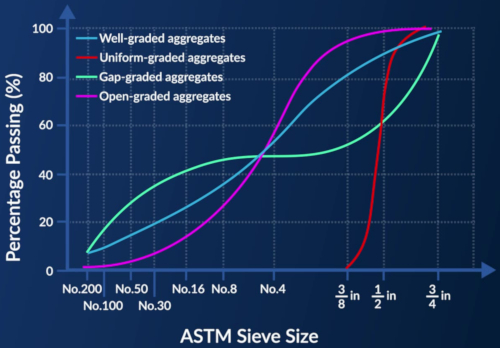5.5 : Rodzaje uziarnienia kruszywa
Uziarnienie kruszywa ma kluczowe znaczenie dla ekonomicznego uzyskania mieszanki betonowej o odpowiedniej wytrzymałości, rozsądnej urabialności i minimalnej segregacji. Istnieją cztery rodzaje uziarnienia kruszywa: dobrze uziarnione, równomiernie (lub jednowymiarowe), szczelinowe i otwarte.
Dobrze uziarnione kruszywa obejmują pełen zakres niezbędnych frakcji wielkości, które pasują do siebie, tworząc gęstą matrycę z minimalnymi pustkami, reprezentowaną przez gładką, ciągłą krzywą uziarnienia. Ten rodzaj uziarnienia zapewnia dobrą urabialność i stabilność betonu.
Natomiast kruszywa o jednym rozmiarze lub jednolitej gradacji składają się głównie z cząstek o tej samej wielkości, co jest widoczne na prawie pionowej krzywej uziarnienia. Chociaż kruszywa te zapewniają dobrą przepuszczalność, brakuje im stabilności i są zwykle stosowane w określonych przypadkach, takich jak uszczelnienia wiórowe w nawierzchniach.
Kruszywa szczelinowe charakteryzują się brakiem pewnych frakcji wielkości, co powoduje, że znaczna część cząstek przechodzi przez dwa bardzo różne sita. W rezultacie powstaje krzywa gradacji z niemal poziomą sekcją, co wskazuje na brak pośrednich rozmiarów. Ze względu na brakujące rozmiary materiałów, kruszywa te mogą powodować problemy ze stabilnością betonu.
Kruszywa o otwartej gradacji, w których brakuje mniejszych rozmiarów wypełniających puste przestrzenie między większymi kruszywami, wykazują płaską krzywą gradacji z minimalnymi wartościami w zakresie mniejszych rozmiarów. Kruszywa te są wysoce przepuszczalne, ale mają zmniejszoną stabilność.

Z rozdziału 5:

Now Playing
5.5 : Rodzaje uziarnienia kruszywa
Aggregates and Water
426 Wyświetleń

5.1 : Niesolidność agregatu spowodowana zmianą głośności
Aggregates and Water
98 Wyświetleń

5.2 : Substancje szkodliwe w ujęciu zbiorczym
Aggregates and Water
153 Wyświetleń

5.3 : Analiza sitowa i krzywe sortowania
Aggregates and Water
313 Wyświetleń

5.4 : Moduł rozdrobnienia
Aggregates and Water
284 Wyświetleń

5.6 : Maksymalny rozmiar kruszywa
Aggregates and Water
86 Wyświetleń

5.7 : Jakość wody
Aggregates and Water
87 Wyświetleń

5.8 : Testowanie jakości wody
Aggregates and Water
103 Wyświetleń

5.9 : Klasyfikacja kruszyw
Aggregates and Water
305 Wyświetleń

5.10 : Kształt i tekstura grubych kruszyw
Aggregates and Water
197 Wyświetleń

5.11 : Wiązanie i wytrzymałość kruszywa
Aggregates and Water
140 Wyświetleń

5.12 : Wytrzymałość i twardość kruszywa
Aggregates and Water
248 Wyświetleń

5.13 : Gęstość właściwa kruszyw
Aggregates and Water
223 Wyświetleń

5.14 : Gęstość nasypowa kruszywa
Aggregates and Water
417 Wyświetleń

5.15 : Porowatość i absorpcja kruszywa
Aggregates and Water
264 Wyświetleń
See More
Copyright © 2025 MyJoVE Corporation. Wszelkie prawa zastrzeżone